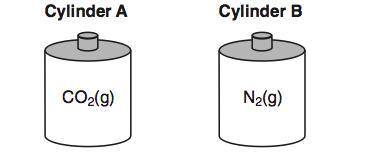
Cylinder A contains 11.0 grams of CO2(g) and cylinder B contains N2(g). The volumes, pressures, and temperatures of the two gases are indicated under each cylinder.
USE INFORMATION BELOW TO HELP:
Va=24.6 L Vb=24.6 L
Pa=1.0 atm Pb=1.0 atm
Ta=300. K Tb=300. K
SELECT ONE:
a. 4.00 mol.
b. 0.250 mol.
c. Not enough information given
e. 0.110 mol.


Answers: 3
Another question on Chemistry


Chemistry, 22.06.2019 05:40
Consider the elements bromine and chlorine; which elements has a larger ionic radius ?
Answers: 1

Chemistry, 22.06.2019 06:30
Melting and boiling are endothermic processes. this means that these processes absorb energy from their surroundings in order to occur. use this information and the data you collected in the phase change gizmo to describe what happens to the temperature of water when you boil it, then explain why this result occurs.
Answers: 1

Chemistry, 22.06.2019 09:00
What type of energy do chemical bonds have? what type of energy is it converted to during chemical reactions? question 15 options: chemical bonds have kinetic energy, which is converted to potential energy during chemical reactions. chemical bonds have electric energy, which is converted to potential energy during chemical reactions. chemical bonds have heat energy, which is converted to kinetic energy during chemical reactions. chemical bonds have potential energy, which is converted to heat energy during chemical reactions.
Answers: 1
You know the right answer?
Cylinder A contains 11.0 grams of CO2(g) and cylinder B contains N2(g). The volumes, pressures, and...
Questions





Mathematics, 22.01.2020 08:31

Mathematics, 22.01.2020 08:31

Mathematics, 22.01.2020 08:31



Mathematics, 22.01.2020 08:31

Mathematics, 22.01.2020 08:31

Social Studies, 22.01.2020 08:31


Spanish, 22.01.2020 08:31

Mathematics, 22.01.2020 08:31

Mathematics, 22.01.2020 08:31

Law, 22.01.2020 08:31

Mathematics, 22.01.2020 08:31

Mathematics, 22.01.2020 08:31

Geography, 22.01.2020 08:31



